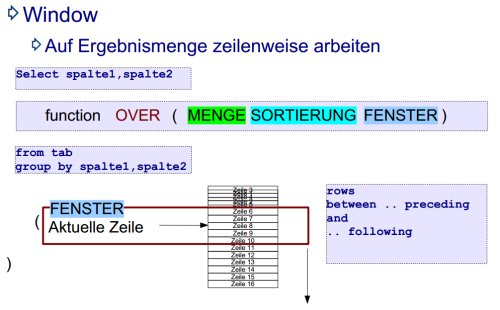Oracle Analytic Function - Beispiel 5 - "Gleitende Summe" und Kumulative Werte berechnen
Mit Hilfe einer Fensterfunktion soll, ausgehende vom aktuellen Datensatz, die Summe der letzten Monate ( mit „ROWS BETWEEN start_point AND end_point“) bzw. die gesamte kumulative Summe (mit „ROWS BETWEEN unbounded preceding AND CURRENT ROW“ ) berechnet werden.
Übersicht
Beispiel Cumlative aufsummieren
Mit „SUM(<Spalte>) OVER (ORDER BY TRUNC(<Treibendes Datum>) ROWS BETWEEN UNBOUNDED PRECEDING AND CURRENT ROW)“ kann der cumulative Wert einer Spalte (über das Datum getrieben) ermittelt werden.
Zum Beispiel für die Darstellung von S Kurven in Primavera:
SELECT prj.id , trunc(actsp.startdate) AS actsp_startdate , to_char(trunc(actsp.startdate),'dd.mm.yyyy') AS displaydate -- BL planned labor units summed by date , SUM(actsp.baselineplannedlaborunits) AS sum_blplannedlaborunits -- BL planned labor units - running totals by date , SUM(SUM(actsp.baselineplannedlaborunits)) OVER (ORDER BY trunc(actsp.startdate) ROWS BETWEEN unbounded preceding AND CURRENT ROW) AS cum_blplannedlaborunits -- Actual labor units summed by date , SUM(actsp.actuallaborunits) AS sum_actuallaborunits -- Actual labor units - running totals by date , SUM(SUM(actsp.actuallaborunits)) OVER(ORDER BY trunc(actsp.startdate) ROWS BETWEEN unbounded preceding AND CURRENT ROW) AS cum_actuallaborunits -- EV labor units summed by date , SUM(actsp.earnedvaluelaborunits) AS sum_earnedvaluelaborunits -- EV labor units - running totals by date , SUM(SUM(actsp.earnedvaluelaborunits)) OVER (ORDER BY trunc(actsp.startdate) ROWS BETWEEN unbounded preceding AND CURRENT ROW) AS cum_earnedvaluelaborunits FROM project prj -- for Securtiy use P6 Tables!! , activityspread actsp WHERE prj.id LIKE (:p_project_id) AND prj.objectid = actsp.projectobjectid AND actsp.startdate BETWEEN to_date(:p_startdate,'dd.mm.yyyy') AND to_date(:p_enddate,'dd.mm.yyyy') GROUP BY trunc(actsp.startdate),prj.id ORDER BY actsp_startdate /
